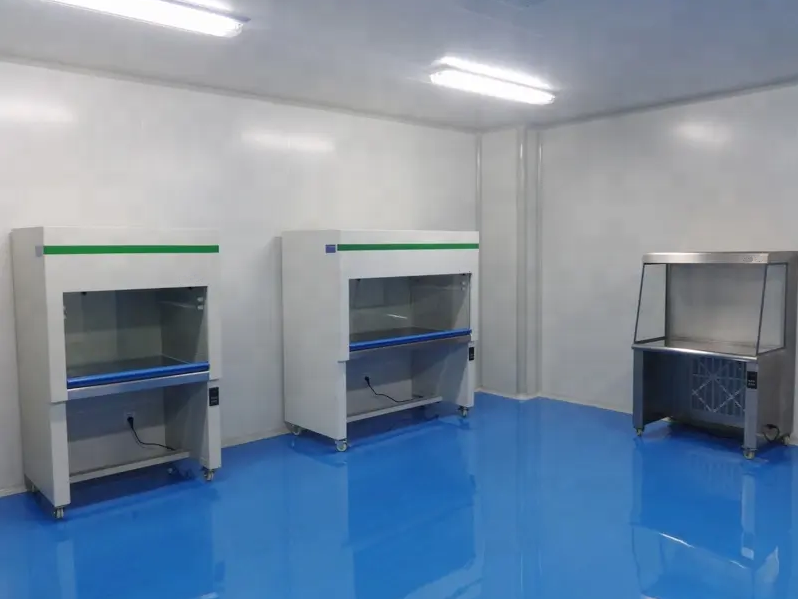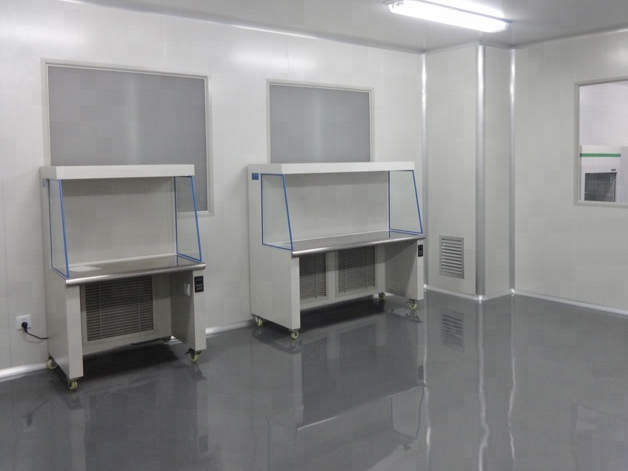

Laminar flow cabinet, also called clean bench, is a general-purpose local clean equipment for staff operation. It can create a local high-cleanliness air environment. It is ideal for scientific research, pharmaceuticals, medical and health, electronic optical instruments and other industries. equipment. Laminar flow cabinet can also be connected into an assembly production line with the advantages of low noise and mobility. It is a highly versatile air clean equipment that provides a local high-cleanliness working environment. Its use has a good effect on improving process conditions, improving product quality and increasing yield.
The advantages of the clean bench are that it is easy to operate, relatively comfortable, efficient, and has short preparation time. It can be operated in more than 10 minutes after starting up, and can basically be used at any time. In clean workshop production, when the vaccination workload is very large and the vaccination needs to be done frequently and for a long time, the clean bench is an ideal equipment.
The clean bench is powered by a three-phase motor with a power of about 145 to 260W. The air is blown out through a "super filter" composed of layers of special microporous foam plastic sheets to form a continuous dust-free environment. Sterile laminar flow clean air, the so-called "effective special air", removes dust, fungi and bacterial spores larger than 0.3μm, etc.
The air flow rate of the ultra-clean workbench is 24-30m/min, which is enough to prevent pollution caused by possible interference from nearby air. This flow rate will not hinder the use of alcohol lamps or bunsen burners to burn and disinfect instruments.
The staff operates under such aseptic conditions to keep the sterile materials from being contaminated during transfer and inoculation. But in the event of a power outage mid-operation, materials exposed to unfiltered air will not be immune to contamination.
At this time, the work should be completed quickly and a mark should be made on the bottle. If the material inside is in the proliferation stage, it will no longer be used for proliferation and will be transferred to rooting culture. If it is a general production material, it can be discarded if it is extremely abundant. If it has taken root, it can be saved for later planting.
The power supply of clean benches mostly uses three-phase four-wires, of which there is a neutral wire, which is connected to the machine shell and should be firmly connected to the ground wire. The other three wires are all phase wires, and the working voltage is 380V. There is a certain sequence in three-wire access circuit. If the wire ends are connected wrongly, the fan will reverse, and the sound will be normal or slightly abnormal. There is no wind in front of the clean bench (you can use the alcohol lamp flame to observe the movement, and it is not advisable to test for a long time). Cut off the power supply in time, and just exchange the positions of any two phase wires and then connect them again, and the problem can be solved.
If only two phases of the three-phase line are connected, or if one of the three phases has poor contact, the machine will sound abnormal. You should immediately cut off the power supply and inspect it carefully, otherwise the motor will be burned. These common sense should be clearly explained to the staff when starting to use the clean bench to avoid accidents and losses.
The air inlet of the clean bench is at the back or below the front. There is an ordinary foam plastic sheet or non-woven fabric inside the metal mesh cover to block large particles of dust. It should be checked frequently, disassembled and washed. If the foam plastic is aged, replace it in time.
Except for the air inlet, if there are air leakage holes, they should be blocked tightly, such as applying tape, stuffing cotton, applying glue paper, etc. Inside the metal mesh cover on the front of the workbench is a super filter. The super filter can also be replaced. If it has been used for a long time, dust particles are blocked, the wind speed is reduced, and sterile operation cannot be guaranteed, it can be replaced with a new one.
The service life of the clean bench is related to the cleanliness of the air. In temperate areas, ultra-clean benches can be used in general laboratories. However, in tropical or subtropical areas, where the atmosphere contains high levels of pollen or dust, the clean bench should be placed indoors with double doors. . Under no circumstances should the air inlet hood of the clean bench face an open door or window to avoid affecting the service life of the filter.
The sterile room should be regularly sprayed with 70% alcohol or 0.5% phenol to reduce dust and disinfect, wipe the countertops and utensils with 2% neogerazine (70% alcohol is also acceptable), and use formalin (40% formaldehyde) plus a small amount of permanganic acid. Potassium is regularly sealed and fumigated, combined with disinfection and sterilization methods such as ultraviolet sterilization lamps (on for more than 15 minutes each time), so that the sterile room can always maintain a high degree of sterility.
The inside of the inoculation box should also be equipped with an ultraviolet lamp. Turn on the light for more than 15 minutes before use to irradiate and sterilize. However, any place that cannot be irradiated is still filled with bacteria.
When the ultraviolet lamp is turned on for a long time, it can stimulate the oxygen molecules in the air to associate into ozone molecules. This gas has a strong sterilizing effect and can produce a sterilizing effect on corners that are not directly illuminated by ultraviolet rays. Since ozone is harmful to health, you should turn off the ultraviolet lamp before entering the operation, and you can enter after more than ten minutes.
Post time: Sep-13-2023

